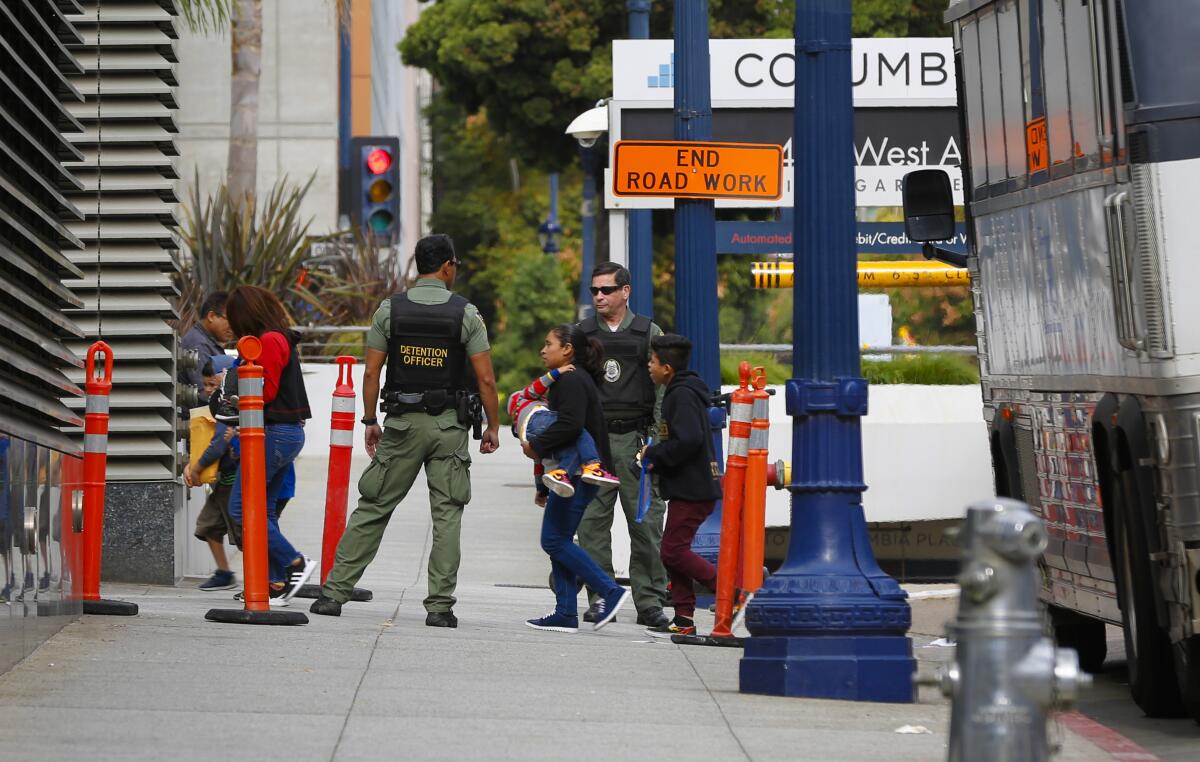‘Remain in Mexico’ one year later: How a single policy transformed the U.S. asylum system

- Share via
SAN DIEGO — Over the last year, the Trump administration has dramatically changed the way that the U.S. asylum system processes many of the people coming to the southwest border to seek protection.
The administration has heralded those changes as a victory for border security, touting reduced numbers of arriving migrants, while people who work with asylum seekers have watched with horror, worried that the potential for protection in the U.S. has disappeared for thousands of people.
The beginning of those changes, known officially as Migrant Protection Protocols, or MPP, was the first major asylum-related policy that the administration managed to implement despite legal challenges in federal court. The program, more widely known as “Remain in Mexico,” requires asylum seekers to wait in Mexico for their immigration court cases in the U.S.
It started a year ago Wednesday with one person — a 55-year-old Honduran man.
His face full of fear and confusion, the man was escorted quickly by Mexican immigration officials away from the United States and into a waiting mob of reporters in Tijuana.
He followed Mexican officials to a van that took him out of the chaos to a shelter.
There would be tens of thousands more after him.
In the days that followed, U.S. border officials began sending groups of migrants from Honduras, El Salvador and Guatemala back across the border to Tijuana to wait for U.S. immigration court cases.
What started as a program for people who came to ports of entry to ask for asylum soon grew to include those who crossed illegally, as well. The program expanded to other nationalities — including people from other Spanish-speaking countries like Cuba and Nicaragua — and to other places along the southwest border.
This week it has expanded further. As first reported by Buzzfeed news, the administration also began implementing the program for Brazilian asylum seekers, the first nationality to be included from a country where the dominant language is not Spanish. (Many returnees who are from Spanish-speaking countries are not themselves fluent Spanish speakers but rather speak indigenous languages like Mam or K’iche’.)
After one year of operation, MPP is now in effect in seven ports of entry along the border in California, Texas and Arizona, and it has returned more than 57,000 people, according to the Department of Homeland Security.
“MPP is one of the most important and effective tools we have implemented to confront the crisis on the border and we will continue to strengthen and expand,” said Heather Swift, spokeswoman for DHS.
Prior to the program, asylum seekers who arrived at the southwest border would either be sent to detention centers or released into the U.S., often to family or friends across the country.
Since its inception, the program has been riddled with logistical mix-ups. Immigration judges have criticized it from the bench, and asylum officers have denounced it as breaking the country’s obligations under U.S. and international law that protect the world’s most vulnerable.
“The asylum officers we represent strongly object to this harmful policy, under which tens of thousands of asylum seekers have been denied due process and placed in dangerous circumstances with inadequate protection or means of support,” the union that includes asylum officers said in a statement on Wednesday.
Early on, reports began to surface of MPP returnees who had been kidnapped, raped or otherwise assaulted in Mexico, sometimes shortly after being returned. In December, a Salvadoran man was killed while waiting in Tijuana for his case.
“People should be just as outraged about this as they are about family separation,” said Lindsay Toczylowski, an attorney with Los Angeles-based Immigrant Defenders Law Center. “People are dying.”
On Tuesday, a Nicaraguan man with a black eye and a bandage above his brow sat in front of San Diego Immigration Judge Philip Law. The man, who was not represented by an attorney, tried to tell the judge that he had been attacked in Mexico, that he was afraid to go back.
“I don’t have jurisdiction in that regard,” Law told the man. He encouraged the man to speak with U.S. Immigration and Customs Enforcement attorney Alvin Ratana after the hearing.
When Ratana requested five weeks to prepare his response to the man’s asylum application, the man pushed back, worried about spending that much more time waiting across the border. Ratana agreed to shorten his request to two weeks.
After the hearing, Ratana promised the man that he would be interviewed by an asylum officer about his fear of return to Mexico. The man breathed a “thank you” in Spanish full of emotion before taking a seat on the court’s wooden benches.
The screening process for fear of return to Mexico uses a legal standard that is much more difficult than the one for asylum itself. People who have been attacked in Mexico frequently end up returned there anyway.
Human Rights First has compiled a database of asylum seekers returned to Mexico who were harmed while they waited. As of mid-January, it had gathered a list of 816 victims.
Since the database relies on anecdotal reporting, it is likely an undercount.
Al Otro Lado, an organization in Tijuana that helps returned asylum seekers, recently had to provide support to a 13-year-old girl who was left alone in the border city after her father “was disappeared” while the family was waiting for the next hearing, according to Nicole Ramos, director of the group’s Border Rights Project.
DHS has said that the program allows for asylum cases to be decided more quickly than they otherwise would. The department argues the speed benefits those whom the law is supposed to protect while filtering out those whom it does not. Critics have countered that the program does not give asylum seekers a fair chance to find attorneys or present their cases.
So far, 187 people of the nearly 30,000 who have finished their proceedings — less than 1% — have won asylum. According to attorneys, the government has appealed every single one of those cases, and some people have been sent back to Mexico even after winning protection in the U.S. while the appeal is ongoing.
Sometimes border officials give returnees fake court dates so that they can be sent back to Mexico even after their cases are finished.
That happened to a woman named Gabriela whose case was terminated, meaning that a judge closed it because the judge believed the government had incorrectly processed her case. She shared her story on Wednesday at a news conference put on by a group of organizations that help MPP returnees.
As her young son clutched her side, she recalled through tears how difficult life in Tijuana had been while she waited for hearing after hearing. She had to rely on the kindness of others to make sure her son had food to eat and a place to sleep.
“When you’re a part of MPP, you don’t have money or food or anything else,” Gabriela said.
As Remain in Mexico rolled out across the border, Innovation Law Lab, along with several other organizations, filed a lawsuit intended to halt the program.
While the case makes its way through federal court in San Francisco, the Remain in Mexico program has been allowed to stay in effect.
“The long game hasn’t proven enough to stop the horrors of MPP,” said Ian Philabaum of Innovation Law Lab. “It is now upon the American public to reject a policy that separates families, sends asylum seekers directly into harm’s way and violates the Constitution.”
More than 40 people representing organizations that help MPP returnees gathered near the San Diego federal court building on Wednesday to criticize the program’s continued existence.
“To be clear, Migrant Protection Protocols is the only urgent crisis happening at our southern border,” said Kate Clark, an immigration attorney with Jewish Family Service.
The program has also brought about new scenarios of family separations. Some families waiting for their court hearings reportedly have decided to send their children across the border alone, knowing that because they are minors, they will be allowed to enter the U.S.
In other cases, the U.S. government makes the decision to separate. Joyce Noche, legal services director of Immigrant Defenders Law Center, told the story of one of her clients, an 18-year-old named Yolanda who had been separated from her pregnant sister when the pair arrived at the border to ask for asylum.
“She was immediately targeted upon return, stalked and harassed by people who saw her for what she was — a vulnerable girl with no one to protect her who had been thrown into the streets,” Noche said. “I have never worried as much about my client’s safety every single night as I do about Yolanda.”
And there is the recent instance of a grandmother who was separated from her 2-year-old granddaughter when they were released from MPP into the United States.
Still others in the program are separated from family members they were intending to reunite with when they came to the border for help.
A daughter flew from Chicago with her mother to be present for her father’s hearing in Judge Law’s courtroom in San Diego on Tuesday. The mother and daughter had come to the U.S. from Venezuela a few years ago to request asylum, but the father arrived more recently and was sent back to Tijuana.
Guards in the courtroom scolded the family for trying to talk to each other, but the father sneaked smiles and sent kisses to his daughter, who cried softly in the back of the courtroom.
Another father, who is a legal resident of the United States, showed up in Law’s courtroom for the hearing of his wife and their 4-year-old son, who are from Cuba. He sat behind them, his son reaching across the back of the bench to hold his father’s hands while the guard wasn’t paying attention.
When it was time for the family to leave, the boy walked behind his mother, reaching up toward his father to be picked up and carried. His father started to comply and then glanced at the guard.
Gently, he placed a hand on the boy and guided him out the door to the officials who would take him back to Mexico to wait for the next hearing.
As for the first man to be returned under MPP, by the time his first court date came around in March 2019, he had crossed illegally into the country at a part of the border where the program was not yet implemented and was being held in custody.
The final outcome of his case is unknown.
More to Read
Sign up for Essential California
The most important California stories and recommendations in your inbox every morning.
You may occasionally receive promotional content from the Los Angeles Times.











